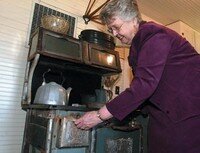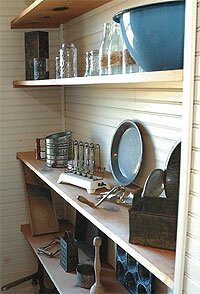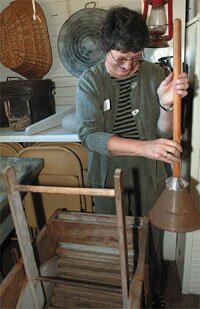Hours: |
|
Mon-Sat 10 - 3 |

What's New: |
Contact SMHS

In the News |
||||||||
|
Thursday, October 02, 2003 Museum strives for historical authenticity:
|
||||||||
 In the Butterfield Cottage, in Seaside, Helen Gaston opens the door of a wood cooking stove where wood is placed. The items at the cottage are from 1912 or earlier. LORI ASSA — The Daily Astorian |
SEASIDE — The little toaster sits quietly on a pantry shelf. Ancient bits of metal and wire no longer glow hot to turn a plain piece of bread into a crispy culinary delight. The toaster has lots of company in the Seaside Museum and Historical Society’s Butterfield Cottage. A cream skimmer, a laundry plunger, cigar box flannels and hair crimping tongs are some of the many items visitors will find when they step back to 1912 at the cottage. Museum volunteers have been busy researching each item to ensure that it meets two important requirements. The first is that the piece dates to 1912 or earlier. The second is that it would have been an item actually used in the house at that time. |
The Butterfield Cottage was built in 1893 by Horace Seely Butterfield, a wealthy Portland jeweler. It was at 21 N. Columbia Street, in “Grimes Grove,” an area of trees between the Necanicum River and the ocean. During the summer, Butterfield moved his family to the cottage and he traveled back and forth between Portland and Seaside.
|
Displayed on the pantry shelves of the Butterfield Cottage are items such as a grater, a slicer, and an early model of an electric toaster. |
 |
“This was his summer home and it was originally just the one room downstairs, one room upstairs and a little kitchen tacked on the back,” said Museum Exhibit Chairwoman Helen Gaston. “Butterfield’s business would close on Saturday at noon and he would ride the Daddy train down and spend the weekend in Seaside.”
In the late 1800s, the only way to get to Seaside was by boat from Portland to Skipanon (now Warrenton). Passengers disembarked at the Skipanon pier and rode a train to Seaside. Families gathered at the railroad station to greet their fathers and the train soon became known as the ‘Daddy train,’” Gaston said.
The Butterfields lived in the cottage until 1903. In 1907, Guy E. DeGolia became the caretaker and in 1912, he married Emelia “Emma” Bitterling Roberts. As a new bride, she furnished the house in the latest style. She lived in the cottage most of her life as the caretaker, renting out rooms to boarders.
The residence became “The House of Roberts” in 1958 when millinery designer Marion Roberts opened a hat shop and was later used as an antique shop. In 1984, the cottage was donated to the Historical Society and moved to its present location at 570 Necanicum Drive. Over the years, it had grown considerably in size, with a pantry, washroom, larger kitchen, dining room, bathroom and four bedrooms added at different times.
The Historical Society decided to restore the house to the 1912 date, rather than its original 1893 construction date because it is now so much larger. Also, volunteers have been able to talk with Emelia’s daughter, who gave them much insight on what the home looked like during that time, Gaston said.
Googling for authenticity
It is important to Curator Mark Tolonen and museum volunteers that the items in the Butterfield Cottage are actually from 1912 or earlier. They do not want reproduction pieces made to look like they’re from 1912.
“By striving for historical accuracy, we’re enhancing the educational aspect of the museum,” he said.
Museum Archives Chairwoman Micki Towell enjoys the reactions she gets when people realize the toaster they’re looking at is really from 1911.
“You get a 16-year-old who really doesn’t want to be here,” she said. “And you tell them ‘this is from 1911. It was really used. This is real.’ It makes a connection.”
Towell, Tolonen and Gaston have been working on the project since last year. Towell estimates they’re about halfway through all of the exhibits. But they’ll never be done, because the cottage displays will constantly change as people donate items to the museum. Each piece must be researched, tagged and counted for the museum’s archives.
One valuable research aid the volunteers use is actually another antique. Advertisements and articles from 1912 (or earlier) editions of Ladies Home Journal and Ladies Home Companion magazines describe what homes looked like.
“They were advocating lightness and fresh air during this time period,” Gaston said.
 |
“This was very different from the earlier heavy Victorian draperies, dark paneling and cluttered rooms. Some Victorians even believed that fresh air could be unhealthy.” Old magazines show near-empty rooms papered with light-colored patterns or paneled with white beadboard woodwork. Electricity was fairly new and appliances were still making the transition. Many homes still retained their wood cookstoves. Indoor plumbing made running water a possibility.
LORI ASSA — The Daily Astorian |
But modern conveniences also are used to authenticate the cottage’s items.
“I’ve been ‘Googling’ all summer,” Towell said, referring to the Internet search engine google.com. “I research when the item first appeared, the materials it’s made from and how it was made.”
If she determines that the piece is indeed from 1912 or earlier and if it might been owned or used by Emelia DeGolia, it is placed in the cottage. If not, it will probably find a place in the museum’s other historical displays.
“The Internet makes research so much easier,” Towell said. “We still have to do our footwork, but the Internet gives us access to more information to authenticate pieces.”
Realistic displays
Towell is also concerned about how cottage items are displayed. She works with Gaston to arrange items as if someone was actually living in the cottage and had recently used them.
For example, residents don’t normally have signs around their house describing each piece and its use.
“Many museums are getting away from the ‘roped off’ approach,” she said. “They are going for a more realistic, hands-on approach.”
Tolonen said one solution to the sign dilemma may be a book that volunteers are creating that will include descriptions and photos of every item on display. Copies of the book will be located at the cottage and visitors may use it as a self-guided tour book. This will help reduce the need for description signs.
Towell and Tolonen are also working on ways to maintain the historical integrity of the cottage’s displays and allow visitors to actually feel and examine exhibits.
“We realize that immersion is important,” Tolonen said. “Each institution has to find its own balance of hands-on and traditional displays.”
Many larger museums with interactive displays have a constant volunteer presence that helps prevent vandalism and damage. However, the Seaside museum’s volunteer base is too small right now to do that, Tolonen said.
Touch tables may be a good solution. This is a table or area that includes duplicates of items that visitors may actually handle. Towell and Gaston have already created a traveling form of a touch table. The Seaside Museum Classroom Discovery Kit contains duplicates of objects that students will see when they visit the cottage. Teachers may borrow the kit to use in the classroom. The two museum volunteers are planning another kit which will include school and leisure activity items.
